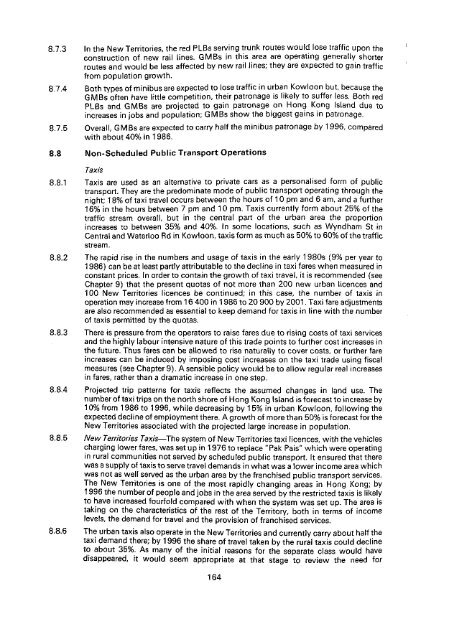Untitled - HKU Libraries - The University of Hong Kong
Untitled - HKU Libraries - The University of Hong Kong
Untitled - HKU Libraries - The University of Hong Kong
- No tags were found...
You also want an ePaper? Increase the reach of your titles
YUMPU automatically turns print PDFs into web optimized ePapers that Google loves.
8.7.3 In the New Territories, the red PLBs serving trunk routes would lose traffic upon theconstruction <strong>of</strong> new rail lines. GMBs in this area are operating generally shorterroutes and would be less affected by new rail lines; they are expected to gain trafficfrom population growth.8.7.4 Both types <strong>of</strong> minibus are expected to lose traffic in urban Kowloon but, because theGMBs <strong>of</strong>ten have little competition, their patronage is likely to suffer less. Both redPLBs and GMBs are projected to gain patronage on <strong>Hong</strong> <strong>Kong</strong> Island due toincreases in jobs and population; GMBs show the biggest gains in patronage.8.7.5 Overall GMBs are expected to carry half the minibus patronage by 1996, comparedwith about 40% in 1986.8.8 Won-Scheduled Public TransportTaxis8.8.1 Taxis are used as an alternative to private cars as a personalised form <strong>of</strong> publictransport. <strong>The</strong>y are the predominate mode <strong>of</strong> public transport operating through thenight; 18% <strong>of</strong> taxi travel occurs between the hours <strong>of</strong> 10 pm and 6 am, and a further16% in the hours between 7 pm and 10 pm. Taxis currently form about 25% <strong>of</strong> thetraffic stream overall, but in the central part <strong>of</strong> the urban area the proportionincreases to between 35% and 40%. In some locations, such as Wyndham St inCentral and Waterloo Rd in Kowloon, taxis form as much as 50% to 60% <strong>of</strong> the trafficstream.8.8.2 <strong>The</strong> rapid rise in the numbers and usage <strong>of</strong> taxis in the early 1980s (9% per year to1986) can be at least partly attributable to the decline in taxi fares when measured inconstant prices. In order to contain the growth <strong>of</strong> taxi travel, it is recommended (seeChapter 9) that the present quotas <strong>of</strong> not more than 200 new urban licences and100 New Territories licences be continued; in this case, the number <strong>of</strong> taxis inoperation may increase from 16 400 in 1986 to 20 900 by 2001. Taxi fare adjustmentsare also recommended as essential to keep demand for taxis in line with the number<strong>of</strong> taxis permitted by the quotas.8.8.3 <strong>The</strong>re is pressure from the operators to raise fares due to rising costs <strong>of</strong> taxi servicesand the highly labour intensive nature <strong>of</strong> this trade points to further cost increases inthe future. Thus fares can be allowed to rise naturally to cover costs, or further fareincreases can be induced by imposing cost increases on the taxi trade using fiscalmeasures (see Chapter 9). A sensible policy would be to allow regular real increasesin fares, rather than a dramatic increase in one step.8.8.4 Projected trip patterns for taxis reflects the assumed changes in land use. <strong>The</strong>number <strong>of</strong> taxi trips on the north shore <strong>of</strong> <strong>Hong</strong> <strong>Kong</strong> Island is forecast to increase by10% from 1986 to 1996, while decreasing by 15% in urban Kowloon, following theexpected decline <strong>of</strong> employment there. A growth <strong>of</strong> more than 50% is forecast for theNew Territories associated with the projected large increase in population.8.8.5 New Territories Taxis—<strong>The</strong> system <strong>of</strong> New Territories taxi licences, with the vehiclescharging lower fares, was set up in 1976 to replace "Pak Pass" which were operatingin rural communities not served by scheduled public transport. It ensured that therewas a supply <strong>of</strong> taxis to serve travel demands in what was a lower income area whichwas not as well served as the urban area by the franchised public transport services.<strong>The</strong> New Territories is one <strong>of</strong> the most rapidly changing areas in <strong>Hong</strong> <strong>Kong</strong>; by1996 the number <strong>of</strong> people and jobs in the area served by the restricted taxis is likelyto have increased fourfold compared with when the system was set up. <strong>The</strong> area istaking on the characteristics <strong>of</strong> the rest <strong>of</strong> the Territory, both in terms <strong>of</strong> incomelevels, the demand for travel and the provision <strong>of</strong> franchised services.8.8.6 <strong>The</strong> urban taxis also operate in the New Territories and currently carry about half thetaxi demand there; by 1996 the share <strong>of</strong> travel taken by the rural taxis could declineto about 35%. As many <strong>of</strong> the initial reasons for the separate class would havedisappeared, it would seem appropriate at that stage to review the need for164
















